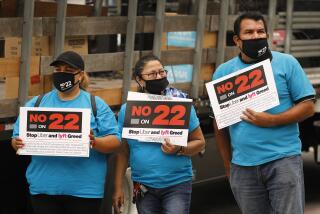Damage Limits in Wrongful Firing Suits Made Retroactive
SAN FRANCISCO — In another victory for employers, the state Supreme Court ruled Thursday that its landmark December decision substantially limiting damages workers can win for wrongful firing applies to what may be thousands of lawsuits that were pending at the time.
The justices, by a 4-3 vote, rejected contentions by plaintiffs’ lawyers that the milestone ruling represented such an abrupt change in the law that it should apply only in future cases.
The Dec. 29 decision, issued by an identical 4-3 vote in the case of Foley vs. Interactive Data Corp., held that a worker fired without good cause in violation of an employer’s promise can sue only for lost pay and related economic losses.
The justices barred awards in such cases for emotional distress and punitive damages. Such verdicts often involve hundreds of thousands of dollars, providing the financial incentive for litigants and lawyers to bring suit. The court’s far-reaching ruling covered the estimated two-thirds of the work force not bound by union contracts or Civil Service agreements.
In Thursday’s decision, the court in an opinion by Chief Justice Malcolm M. Lucas found that there was “no compelling reason” to make an exception to the general rule that judicial decisions are to be given retroactive effect.
The limitations on damage awards and other findings in the Foley ruling will apply to “all cases not yet final” on Jan. 30, the date the decision became final, Lucas said.
The issues raised in the Foley case were “indisputably unsettled” at the time of the decision, and litigants in pending disputes must have been aware of the legal uncertainties surrounding their claims, the court said.
It would be just as unfair to deprive defendants of the benefits of the new rule of law as it would have been to deny plaintiffs the new rights they have won retroactively in other decisions issued by the court over the years, the justices said.
Meanwhile, the court said, plaintiffs in pending cases can still amend their lawsuits to try to meet the requirements issued in the Foley decision.
In dissent, Justice Allen E. Broussard, joined by Justices Stanley Mosk and Marcus M. Kaufman, said retroactive application will prove “catastrophic” to fired workers who had brought suit relying on state appellate court decisions allowing larger damage awards.
“Evenhanded justice requires that we find the exception (to the rule) applicable here,” Broussard wrote.
Thursday’s decision was welcomed by Steven G. Drapkin of Los Angeles, attorney for the 3,500-member Merchants and Manufacturers Assn., one of several employer groups urging the court to apply the Foley decision to pending cases.
“We’re obviously delighted that the court has shown it will not retreat from its ruling, even in the face of pressure from the personal injury Bar,” he said.
While no precise figures were available, wrongful discharge suits pending in California may well number “in the thousands,” Drapkin noted. Thursday’s ruling will affect not only cases awaiting trial but also those that have resulted in awards and are on appeal, he said.
The attorney noted, for example, that the pending $10.5-million damage award on appeal won by actress Raquel Welch for her dismissal from the 1982 movie “Cannery Row” appears to be subject to substantial reduction.
Brad Seligman of Oakland, an attorney who represented the California Trial Lawyers Assn. in the case, assailed Thursday’s ruling as reflecting the court’s “gross insensitivity” to workers.
He said the court in the Foley decision deprived employees of their “broadest and most effective” weapon against unfair dismissal: the threat of substantial damages.
“The court said then it didn’t care about the severe emotional trauma of termination,” Seligman said. “Now it’s going a step further by saying it doesn’t care either about those who brought suits based on what they thought was settled law. For these workers, the court’s changing the rules in midstream.”
Thursday’s decision came in the case of Robert Newman, a former branch manager for Emerson Radio Corp. in Los Angeles who contended that he had been wrongfully dismissed in May, 1982.
The justices ruled that the Foley decision will apply to Newman’s claims, but that Newman could amend his suit to seek the limited damages for violation of contract, as allowed under the December ruling.
Lucas’ opinion was joined by the same three court members who helped form the majority in the Foley decision--Justices Edward A. Panelli and David N. Eagleson and now-retired Justice John A. Arguelles, sitting by special appointment.
The chief justice pointed out that the rule of retroactivity was “basic in our legal tradition” but noted that there were some exceptions. One such exception, he conceded, took place last August when the court applied only to future cases a ruling barring accident victims from suing the wrongdoer’s insurer for improperly denying a claim.
But in the August decision, the court was overturning its own previous ruling permitting such lawsuits--one that had served as a basis for litigation for nine years, he said.
Further, Lucas said, while there had been several state appeal court rulings in wrongful discharge cases allowing emotional distress and punitive damage claims, there was still “anything but near-unanimity” on what precise legal standards to apply in such cases.
Meanwhile, in other wrongful discharge cases before the high court in recent years, the justices had “expressly declined” to rule on the critical issues subsequently raised in the Foley dispute, he said.
The court acknowledged the application of the Foley decision to pending cases will result in some retrials but said the number will not be sufficient to “seriously disrupt the administration of justice.”
More to Read
Inside the business of entertainment
The Wide Shot brings you news, analysis and insights on everything from streaming wars to production — and what it all means for the future.
You may occasionally receive promotional content from the Los Angeles Times.










